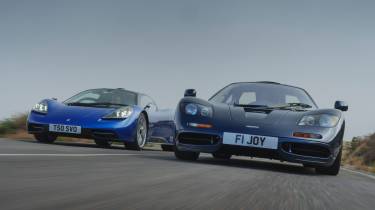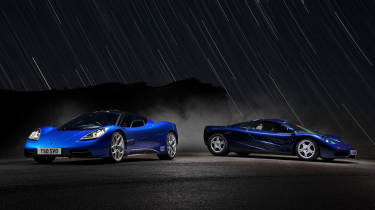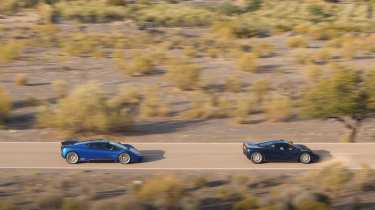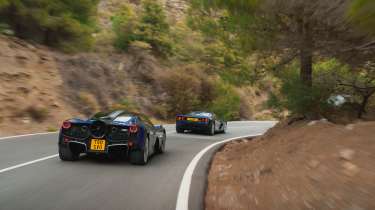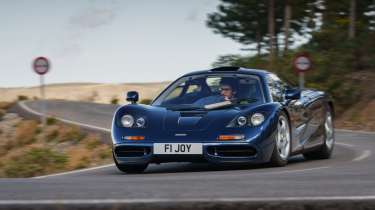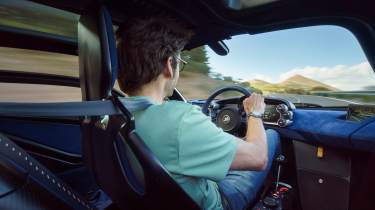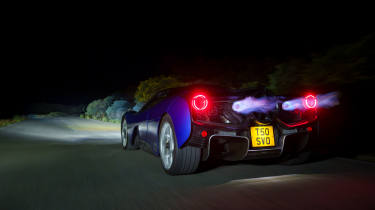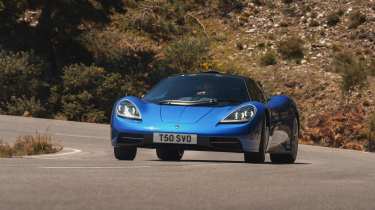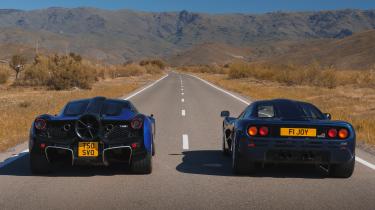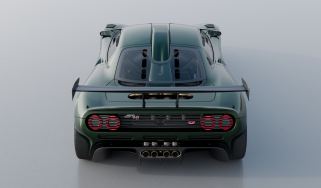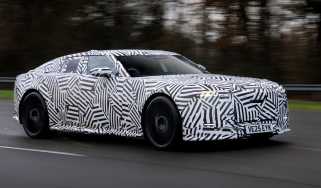GMA T.50 v McLaren F1 – has the best car in the world been dethroned by its successor?
We test Gordon Murray's hypercar dynasty – the McLaren F1 and the GMA T.50 – head to head to see which comes out on top as the ultimate exotic
At the summit, I call my son. It’s nearly bedtime back home, but I have to share this. Outside, the sky is a wash of pinks and purples set over a cloud inversion that is filling the valley below like Chantilly cream on a sundae. There is nobody around. My hands are still shaking slightly. ‘Hi Daddy!’ ‘Hi dude, listen to this…’ and I blip the throttle, once, twice. YEEOW! YEEOW!
The cockpit and surrounding mountains are filled with furious five-digit revs. A V12 with the response of a superbike engine. ‘Wowww! That is sooo cool!’ That is not a generic reaction. He might be only seven, but he knows his cars. ‘I’ve just had the most amazing drive,’ I say. ‘This car is unbelievable! I’m about to head back down the mountain, but I just wanted you to hear that.’ ‘Thank you, Daddy.’ ‘Love you! Sleep well.’
As the screen goes black I press the tiny, covered button behind the gearlever to still the titanium valves for a minute or two. Take a few breaths, enjoy the moment, be present… all that stuff we’re meant to do every day but never have the time for. Because I need to mentally bottle this, tuck it away in the old hippocampus for rainy days years from now. Even in this job, drives like that don’t come along very often. I’ve been lucky enough to have a few in the McLaren F1 and now I’ve got one in the GMA T.50 to add to the mental scrapbook.
A beautiful, deserted road and a car that requires every bit of your attention but rewards with sensations and sounds that are the stuff of dreams. A car that feels worth its sky-high price tag, yet immerses you in the driving experience so deeply that you forget any such figures and drive it with the joy and abandon of a hot hatch. And the best bit is that I’ve still got the return journey ahead of me…
More reviews
Rewind just over a week and I’m sitting in the new Gordon Murray Automotive HQ in Windlesham, the man himself the other side of a glass coffee table. Typical of a room in a building with his name on it, there is also an old jukebox in here. I’m aware that you want to hear more about Spain, so we won’t dally, but I think the conversation provides essential context and is worth a synopsis.
The story of the T.50 is one of time and money. Or rather, timing and money. Murray tells me that he felt that there w§as no point doing a successor to the F1 before now because things hadn’t moved on enough to make a sufficiently big leap. In his view, fabulous though things such as the F50, Zonda and Carrera GT were, nothing in the next couple of decades really exceeded the F1 and moved the game on in terms of a pure, analogue, naturally aspirated, lightweight supercar. But the 50th anniversary of the start of Murray’s career and some urging from people around him, combined with advances in materials and technologies, made him think that the time was right for another go.
Just as importantly, the money was there. Where the F1’s development budget was just £8million, the T.50’s could be considerably more, even allowing for a quarter-century of inflation. No corners had to be cut. If they wanted to invest a few million in developing lights rather than taking them off a shelf also frequented by coach manufacturers, they could. The folding on the other side of the equation has clearly changed over the years as well. Where McLaren famously struggled to sell 60 F1 road cars for £634,500 each in the mid-’90s, there is now a much hungrier market for the ultra-expensive.
So, just as the likes of Peter Stevens, Barry Lett and Steve Randle had gathered to develop the F1, so a new team assembled for the T.50. But what to do with the opportunity that time and money presented? Well, first there were the things that the F1 didn’t get quite right for one reason or another, chief among them being the brakes. Murray wanted to have carbon stoppers on the McLaren, but the technology just wasn’t there at the time. The eventual cast-iron items needed very hard pads to cope with stops from the high speeds the F1 is capable of, but these squeal like a litter of Gloucestershire Old Spots.
The air-con also isn’t up to snuff, the headlights are weak, the unassisted steering is heavy at parking speeds, the bespoke tyres have caused supply problems, the luggage compartments are a bit awkward and the motorsport bag-tank has a relatively short shelf-life and is an engine-out job to replace. Mostly these are not things that really affect its performance as a driver’s car (even the brakes work well enough if you ignore the noise), but as Murray says, they’re things that are a pain if you’re an owner and actually use the car.
Then we have the areas that Murray simply wanted to try to take to the next level, facilitated by the aforementioned advancements of technology (such as 3D printing and better knowledge of carbonfibre) and a bigger budget. Trifling things like the engine, the weight-saving, the aero and what Murray describes as the engineering art…
Fast forward a week and the two three-seaters are side-by-side in Spain, warming in the morning sun: chassis #46 (the same F1 that appeared in issue 205) fresh from a service and PS4 (Pre Series 4), the final T.50 prototype before the customer cars.
We’re in Spaghetti Western country, mainland Europe’s only desert. The amazing roads that writhe off up into the mountains with more turns than a coiled lasso might as well have tumbleweed on them for all the traffic they see. And having both cars here feels like something from Hollywood, a blockbuster shoot-out if ever there was one, but also a little unreal. It’s akin to John Wayne and Clint Eastwood finally meeting: a generational showdown.
Just like in the films, the heroes are surprisingly closely matched. The T.50 has just 34bhp more (661bhp plays 627), but the F1 packs a punch that is 126lb ft more torquey (479lb ft versus 353). The younger car is trimmer, with an astonishing 997kg dry weight besting the F1’s dry value by 21kg. But how noticeable will that be? And while the F1’s figures of 3.2 seconds to 60mph and a V-max north of 240mph are the stuff of legend, GMA has revealed only a top speed figure for the T.50: 226mph.
It’s a genuinely intriguing match-up and, in my mind at least, certainly not a foregone conclusion. Perhaps they shouldn’t even be viewed as adversaries at all, more like Butch Cassidy and the Sundance Kid. Only one way to find out…
Sitting in an F1 is always special. Time hasn’t dimmed the excitement of clambering, shuffling and swivelling (there is no really elegant way) into the centre, resting your feet on the beautiful pedals and drinking in the fabulously clear black-on-white dials. The way the slim bucket is set ahead of the flanking passenger pews gives a single-seater feeling of priority to the driver. And once you’ve adjusted to the idea that you’re in the middle, you also realise just how far forward in the car you are.
Twist the key, wait for the small, digital display to run through the system checks and then press the red starter hiding under a cover in front of the gearlever to wake Paul Rosche’s 60-degree masterpiece into a slightly lumpy initial cold idle. Select first gear and you notice both the narrowness of the gate and the resistance that you know will dissolve as the fluids warm over the first few miles.
I take it nice and steady to the petrol station and then on along the main road, enjoying novelties like the four mirrors and the sight of a T.50 reflected in them, Nik Hoyle, GMA’s quietly spoken but enthusiastic and talented chief engineer (vehicle product) at the wheel. Then we turn inland and as we make our way across the flatlands, the range of mountains rising ahead like ramparts protecting a kingdom beyond, it’s finally time to stretch the F1’s legs.
A long straight cuts through a rocky outcrop and, with a clear view ahead, tarmac shimmering slightly like water in the heat, I leave the gearlever top-right in fifth and just press the throttle all the way into its travel. Digging into the torque from low revs in a high gear like this gives the best opportunity to really immerse yourself in the intoxicating induction bark, to extend that angry, animalistic growl for as long as possible as the speed builds. The fact that the F1 is relatively quiet at low revs and small throttle openings makes this sudden plunge into the auditory deep end even more gratifying. Even in full cry, however, the BMW S70/2 isn’t loud enough to obscure the higher-pitched voice of the other car in the convoy as it gives chase. It’s like a tenor and soprano duetting.
At the end of the straight we’re into some medium-speed sweepers and I’m careful to lean on the brakes early and get the F1 settled because I know from experience that this is not a car in which you want to be trailing the brakes hard towards an apex. With soft suspension, the resultant dive and roll means you will feel the momentum of the V12 behind you start to build like a big rucksack with the straps not done quite tightly enough. Combine this with heavy steering and it’s a recipe for unruliness. Like a spilt pint in the wrong pub, things can get out of hand quite quickly.
Except this car has been to finishing school since I last drove it. I think I must be imagining it at first, but a few corners in I’m sure something is different. The fundamental traits I’ve just mentioned are still there and there is still no rear anti-roll bar, but there is a touch more support in the suspension, a smidge less lean and squat and dive. I find out from Murray later that it’s a set-up that has been offered to customers who didn’t like the standard softness. It doesn’t go as far as the firmer LM in dialling out the GT side of the F1’s character, but it definitely instils more control and confidence.
This is even more evident as we begin to climb. Up into the clear cyan sky where the straights are shorter and the stabs of acceleration briefer but the hairpins also let you load the substantial sidewalls of the F1 more and more. The heavy helm requires real upper-body effort through the tight 180s, but as I get into a rhythm and feel happier in the balance I can’t help but use the throttle to do some of the steering.
Turn in, feel the slight push of the nose as the wheel goes a fraction lighter in your hands, a little lift of your right foot to transfer the weight and then back down for a quick bark of throttle to unstick the big 315-section rears. They’ll spin up quickly and the tail swings fast, but the steering knows what to do and you can let the perfect circle run through your hands into opposite lock as the car arcs round behind you. If you’ve got it right you’re now sliding an F1 and happier than Larry. Keep the throttle judiciously applied, let the grip bleed back in, wind the lock off and accelerate away, heart beating that bit faster.
I’m not going to lie, with no ESP and so much torque to trigger, you need to pick your corner and tread with the sort of care and consideration you would on a tightrope if you don’t want things getting worryingly wayward. But there is more to the F1 than just the straights. It’s a car that I don’t think you would ever get bored of because the weight transfers require constant attention and you need to concentrate on how you mix positivity with precision and delicacy in the way that you interact with the sometimes heavy controls.
But the rewards for all this focus and effort are absolutely worth it and I get more and more comfortable as we climb higher and higher, sometimes blurring through tunnels of dark pine trees, other times driving right out onto exposed hairpins with elevated views away to the Mediterranean in the south. One last straight, one more hit of that giddy sensation of almost falling down the road as the 6.1 litres make a mockery of the carbon car they’re attached to, then we’re as high as we can go. Time to park up, take in the view, take stock, take some photos.
Getting into the T.50 for the first time requires either a blip of the key (NB: press the button for the left-hand door – if you press the open padlock button you’ll open both doors and both top-loading luggage compartments, which is fabulously dramatic but will also require you to go round and shut them all) or a press of a tiny button behind the wing camera, suggesting that Murray’s brief dalliance with TVR might have rubbed off a little. Access is slightly easier here thanks to the absence of the F1’s central carbon beams, but it’s still a bit of a clamber-shuffle-swivel.
Once you’re in, it all feels almost spookily familiar even though everything has changed. It’s a bit like reading the first chapter of a new book in a series you like. Even if the location is new or the characters have changed, something about the words, the phrasing, the underlying tone brings it all flooding back. You can tell the author is the same.
Here the seat is the same svelte shape but with the padding pared back to just the pressure points. Likewise the steering wheel – still three-spoke and simple – feels a little slimmer. Two little paddles for the horn (right) and main beam headlights (left) are located behind the cross spar, just as on the F1. And there are now buttons for the indicators, but they’re flush so there’s no chance of knocking them. Behind the wheel is a big, brushed-metal rev-counter. It’s uncluttered and beautifully legible like a pilot’s watch. But unlike a watch the numbers go up to 13.
The rotary switches are grooved rather than smooth like the F1’s, tactile as you twist, but in a light, almost delicate way. There’s a little red metal (nothing is plastic) cover behind the gearlever, as light as a tiddlywink. Flip it up, give the surprisingly small starter button beneath a short push and this wakes the screens that are set slightly back like passenger seats either side of the central rev-counter. Dip the clutch (the pedals are a prime example of the ‘engineering art’), another short push on the button and you’ll hear noise behind you. A disappointing noise.
You’ll be 3.5 seconds through thinking that a V12 really should sound better than this when… brRAWRrrrrrrr! Cosworth’s creation erupts into life and startles anyone in the locality not expecting it (driver included!). The prelude was merely the integrated starter-generator doing its thing. Think of it as GMA’s version of the traditional, theatrical, Lamborghini long starter-motor spin. Just don’t stall it if you’ve got a queue of traffic waiting behind…
If there’s a small orange light illuminated like a drop of lava in the centre of the rev-counter then you know that the engine oil still needs warming. However, after a first exploratory blip of the throttle pedal I know it’s going to take me at least a few miles to recalibrate to the response of this engine. I’ve always thought the F1’s 6.1-litre V12 felt sharp, but this 4-litre V12 appears to have no inertia at all; 50,000rpm per second is the astonishing rate at which the revs will flash and evaporate. Odds-on it will be ready for the red line before I am.
The clutch isn’t grabby, but care is needed. The steering has power assistance below 10mph, so manoeuvring is much more manageable than in the F1. I’m not convinced about having screens instead of mirrors, but I suspect that familiarity might make them feel more natural. And overall there is an even greater sense of visibility as you set off down the road, the glass panels in the roof giving a Zonda-like feeling of airiness to the cockpit.
Just as in the F1, the gearbox clearly needs warming as much as the engine, but the simple sphere on a slender stick falls perfectly to hand. It’s a reassuringly positive shift, but it’s not slick and smooth. You don’t fingertip-flick it around the gate, nor do you slide it fluidly like the six-speeder in a Cayman. There is real resistance. It reminds me a little of the six-speed in the 997.2 GT3 – a tough, businesslike shift, albeit with an even tighter, shorter throw in the T.50.
Explore the menus and you’ll find a rev-match function that you can turn on; it’s actually incredibly helpful in the first few miles because it’s like a training aid, helping you get your ear in and attune to the way the engine note rises and falls. There is also a slightly softer GT throttle setting, which is a boon to begin with, but you soon find you actually want the accuracy of Sport, which gives you a perfectly predictable linear map.
Nonetheless, such is the rapier response that a new level of sensitivity is required in your right foot; there are probably scalded cats that are slower to react. In the first few miles, as I head down the other side of the mountain, I’m uncertain if I’ll ever be able to blip accurately enough to heel-and-toe. In fact it reminds me of my first time left-foot braking. But the sensitivity in your sole is there, you do find new accuracy in your ankle articulation, and when you first nail a three-pedal downshift it feels all the more rewarding. It unlocks another layer, your connection with the car tightens and it gives you the confidence to go a bit faster, to delve deeper into the dynamics.
The steering has weight to it – much more than most – but doesn’t require effort like the F1’s. And it’s weight that really ebbs and flows with load. At moderate pace, not pushing hard, there’s a little lightness to the nose on initial turn-in to corners, a moment before it really leans and loads. It’s a front end that feels like it wants to be primed with some braking. Overall the ride supplied by the passive R53 dampers is more connected than the F1’s. There’s still travel and compliance in the bigger primary movements but more detail over the smaller bumps, adding to the sense of a more focused car.
The stopping power is certainly a huge step on. The Brembo CCM‑R brakes (which we first saw on the McLaren Senna) are mighty and, unlike the F1’s, have ABS. They also have the assistance of the fan in the rear, which instantly spools up under heavy braking, energising the diffuser and moving the centre of pressure rearwards so that the car stays flat rather than diving. I’d like a little more resistance right at the top of the pedal travel as I think it would better match the rates and responses of the other controls, but overall it’s astonishing and another vivid reminder of the benefits of weight saving.
As with the rev-match function, ESP is also very welcome while you settle in. You notice the little telltale light flashing on the left-hand screen, but it doesn’t hinder, just helps. Give the button to your right a push and the ESP Sport setting slackens things just the right amount when you start to feel more at home.
But while you notice all these little things, it’s unquestionably the engine that dominates the first drive in a T.50. I remember when the 911 R came out: the first time we’d been treated to that really high-revving flat-six combined with a manual gearbox. Summoning the nerve to actually hold a gear and watch the revs climb all the way to 9000rpm was not something you did lightly. It was thrilling but took a certain amount of pluck. This is like that experience, but squared.
The first time you bury the throttle and don’t short-shift at 8 or 9 or 10 or 11 but climb all the way to 12 before taking your hand off the wheel and going for the next gear… well, it’s enough to make you feel giddy with the emotional cocktail of exhilaration and focus, with a sprig of elation and a dash of fear. If space permits and you can flash through a change to repeat the process in the next ratio as well, then it’s almost transcendental.
I swap seats several times during the afternoon, snatching a few minutes in one car then a few in the other as pixels are captured, each time noticing something new: on the T.50 the delightful reverse lockout switch, the soft close on the doors, the fact you’ve yet to find a use for the Arcam stereo that weighs just 3.9kg (or about half that of the Kenwood system in the F1). But as evening approaches, the air begins to cool and we decide to head for ‘home’, I get into the F1 for the run down through the hairpins. Slotting in behind the T.50, it’s fascinating following the fan and, as the overhead harshness fades from the light, so I catch glimpses of glowing orange exhausts. Go harder still and they will treat you to the occasional brief stab of blowtorch-blue flame.
Even after the T.50, the F1 still feels special, which is a relief somehow. It needs more care, feels meatier, sounds meatier, but also has a bit more comfort. It can play the GT car more than the T.50 and you could imagine using one every day – it has the ability to speak softly (albeit always deeply) while carrying that big, mid-mounted stick. And as we head back along the flatland straights, two small shapes spearing through the buff, bare landscape, it certainly doesn’t feel slow.
Everyone else heads to dinner once we’re back, but I still feel I need a longer run in the T.50, away from the requirements of cameras – more miles to finish getting to know it. Food can wait. So I borrow the surprisingly large key and head back out, towards the mountains again.
Twenty minutes later I definitely feel like I know the T.50. No distractions, not a single other car around, just me, that engine and a chassis that is now revealing the true purpose of all the engineering effort that has gone into it. The harder you drive it, the more the car encourages you. Having just 178kg (or only two-thirds of an F1 engine) behind you and mounted incredibly low in the chassis (the centre of mass is 100mm lower than in the F1) means that now there is no fear of things getting unruly unless you want them to.
Because of the raft of similarities, your brain says to be careful, but this is not like the McLaren. The more you grab the T.50 by the scruff of the neck and drive it hard, the more it seems to reward you. The lightness of the whole car becomes ever more evident. The gearshift that was perhaps a little stiff now makes sense because the total lack of slack or slop means you can shift as quickly as possible with utter confidence.
You crave the straights so that you have the chance to hear and feel the engine scream like a Formula 1 car from the era of the F1. I’ve never known acceleration so addictive. It doesn’t have that beautiful, rich induction sound of the McLaren but its frenzied fierceness, like VTEC on fast-forward, makes the hairs stand up on the back of your neck every time you crack the throttle.
But the rest of the car isn’t just a vessel for the V12; the chassis is fun and lets you feel you can truly use the engine rather than just experience it. There is a predictability and playfulness in the corners that combines with the razor-sharp response of the engine to let you balance the car with a sort of wide-eyed ease.
As with the F1, the slight softness in the nose lets you feel the front on turn-in before loading the rear. But here there is real friendliness in the way the T.50’s LSD lets you light up the narrower 295-section rear tyres and keep them fizzing as the car almost floats into oversteer, accelerating out of corners with a quarter turn of lock until you need to change up. At one point the generally pristine road becomes riddled with bumps from tree roots, but the rear feels faithful and there’s no need to lift even as the revs and rears flare momentarily. It seems to thrive on being up on its toes, agile and alive.
As I keep driving, keep pushing, never relaxing but constantly smiling, I’m struggling for reasons why this isn’t the most thrilling road car I’ve ever driven. Imagine an Alpine A110 with the feedback and control weights of a Caterham Seven and an engine from another planet. Except you’re sitting in the middle. And then you realise that being in the middle has become more than just interesting. You really want to be absolutely at the centre like this, in perfect harmony with the car. Balanced. At the summit, I pull over and make the phone call.
| GMA T.50 | McLaren F1 | |
|---|---|---|
| Engine | V12, 3994cc | V12, 6064cc |
| Power | 661bhp @ 11,000rpm | 627bhp @ 7500rpm |
| Torque | 353lb ft @ 8000rpm | 479lb ft @ 4000-7000rpm |
| Weight | 997kg (dry), (674bhp/ton) | 1018kg (dry), (626bhp/ton) |
| Tyres as tested | Michelin Pilot Sport 4 S | Michelin Pilot SX |
| 0-60mph | <3sec (est) | 3.2sec |
| Top speed | 226mph | 240mph |
| Price (new) | £2.8million | £634,500 (£1.3m in today’s money) |

